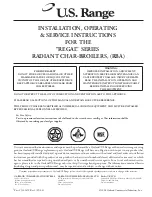
29
Glossary
Greenstar i
ErP
- 6 720 806 946 (2015/03)
12
Glossary
Central heating systems
All radiators must be heated at an even rate. If the top of a radiator is at a lower temperature than the bottom then it should be bled
by releasing air through the bleed screw at the top of the radiator.
Ask your installer to show you how this is done.
This appliance is fitted to a sealed system. Should water leaks be found or if excessive bleeding is required, then a service engineer
must be contacted to inspect the installation and rectify any fault.
Only additives that are compatible with aluminium may be used in the system. Any incompatible additive used will invalidate the
guarantee.
Pluming and condensate drain
This is a condensing appliance and the flue terminal will, at times, give out a plume of water vapour. This is quite normal.
The appliance produces condensate which is discharged regularly by a syphon within the appliance via a plastic pipe to a drain. This
pipe must not be blocked or altered in any way.
Room thermostat/programmer
A room thermostat / programmer must be fitted to control the central heating. This controls the times and temperatures of the
central heating, preventing the appliance from firing unnecessarily. Refer to the instructions supplied with the thermostat and
programmer for further information.
Thermostatic radiator valves
Thermostatic radiator valves must be fitted in sleeping accommodation. It is recommended that this type of valve is fitted to all but
one of the radiators. The remaining radiator, where the room thermostat is located, must be uncontrolled and left open.
Pump over run function
After the appliance has finished a demand for central heating or hot water, the pump may continue to run for a short while to
dissipate the heat from within the appliance.
Pump anti-seizure
If there has been no heating demand for 24 hours, the appliance will run the system pump for a few seconds to reduce the possibility
of pump seizure during long periods of inactivity.




































